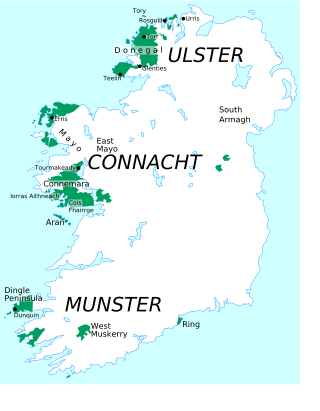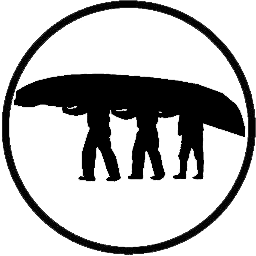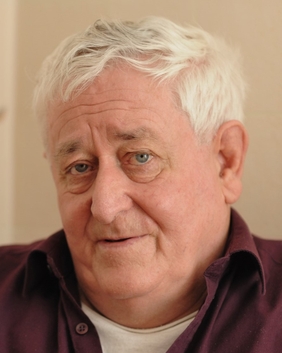Although Irish has been used as a literary language for more than 1,500 years, and modern literature in Irish dates – as in most European languages – to the 16th century, modern Irish literature owes much of its popularity to the 19th century Gaelic Revival cultural movement. Writers in Irish have since produced some of the most interesting literature to come out of Ireland, supplemented by work produced in the language abroad.

Connemara is a region on the Atlantic coast of western County Galway, in the west of Ireland. The area has a strong association with traditional Irish culture and contains much of the Connacht Irish-speaking Gaeltacht, which is a key part of the identity of the region and is the largest Gaeltacht in the country. Historically, Connemara was part of the territory of Iar Connacht. Geographically, it has many mountains, peninsulas, coves, islands and small lakes. Connemara National Park is in the northwest. It is mostly rural and its largest settlement is Clifden.

Máirtín Ó Cadhain was one of the most prominent Irish language writers of the twentieth century. Perhaps best known for his 1949 novel Cré na Cille, Ó Cadhain played a key role in reintroducing literary modernism into modern literature in Irish, where it had been dormant since the 1916 execution of Patrick Pearse. Politically, Ó Cadhain was an Irish republican and anti-clerical Marxist, who promoted the Athghabháil na hÉireann, . Ó Cadhain was also a member of the post-Civil War Irish Republican Army and was interned by the Irish Army in the Curragh Camp with Brendan Behan and many other IRA members during the Emergency.

Ulster Irish is the variety of Irish spoken in the province of Ulster. It "occupies a central position in the Gaelic world made up of Ireland, Scotland and the Isle of Man". Ulster Irish thus has much in common with Scottish Gaelic and Manx. Within Ulster there have historically been two main sub-dialects: West Ulster and East Ulster. The Western dialect is spoken in County Donegal and once was in parts of neighbouring counties, hence the name Donegal Irish. The Eastern dialect was spoken in most of the rest of Ulster and northern parts of counties Louth and Meath.

Munster Irish is the dialect of the Irish language spoken in the province of Munster. Gaeltacht regions in Munster are found in the Gaeltachtaí of the Dingle Peninsula in west County Kerry, in the Iveragh Peninsula in south Kerry, in Cape Clear Island off the coast of west County Cork, in Muskerry West; Cúil Aodha, Ballingeary, Ballyvourney, Kilnamartyra, and Renaree of central County Cork; and in an Rinn and an Sean Phobal in Gaeltacht na nDéise in west County Waterford.

Cló Iar-Chonnacht is an Irish language publishing company founded in 1985 by writer Micheál Ó Conghaile, a native speaker of Irish from Inis Treabhair in Connemara. He set the company up while still a student.

Joyce Country is a cultural region in counties Galway and Mayo in Ireland. It is sometimes called Partry, after the former tribal territory of the Partraige, which it largely matches. Part of it falls within the Connacht Gaeltacht. Joyce Country lies on the shores of Lough Mask and Lough Corrib, and includes the Partry Mountains. It is a rural area that includes small settlements such as Clonbur, Cong, Cornamona and Toormakeady. It borders Connemara, to its south and west.
Seán Ó Tuama was an Irish poet, playwright and academic.
Dara Ó Conaola is an Irish writer who writes in Irish. His first book of short stories, Mo Chathair Ghríobháin, was published in 1981. A later short book of eight short stories, translated to English by Gabriel Rosenstock, was published as Night Ructions in 1990. The book was launched at the 1990 Sunday Times Festival of Literature, Hay-on-Wye, Wales.

Cathal Ó Searcaigh, is a modern Irish language poet. His work has been widely translated, anthologised and studied. "His confident internationalism", according to Theo Dorgan, has channeled "new modes, new possibilities, into the writing of Irish language poetry in our time".
Micheál Ó Conghaile is an Irish-language writer who lives in Indreabhán, County Galway, Ireland. He was born on the island of Inishtravin in Conamara and was raised in an Irish-speaking community.
Conamara Theas is a predominantly Irish-speaking district in the West of County Galway. There are around 7,000 people living in the area. Between 60% and 80% of residents are native Irish speakers. It is the part of the Gaeltacht that is west of Cois Fharraige. The Conamara Theas variety of Connacht Irish is different from that of Cois Fharraige.
Sáirséal agus Dill was a publisher of Irish-language books based in Dublin, Ireland.
Pádraig Ó Siadhail was born in Derry, Northern Ireland, in 1957, and now lives in Halifax, Nova Scotia, Canada. He is a scholar and writer and has published prolifically in the Irish language.
Daithí Ó Muirí is a writer of fiction in the Irish language. He was born in County Monaghan but now lives in the Cois Fharraige district of Connemara.
Pádraic Breathnach is an Irish short story writer and novelist who writes in the Irish language. He was born in Moycullen, County Galway and now lives in Limerick. He has won a number of Oireachtas prizes. He was also awarded The Butler Literary Award by The Irish American Cultural Institute in 1992. In 1972 he joined the school of Celtic Studies at the Dublin Institute for Advanced Studies.

Maidhc Dainín Ó Sé was an Irish writer and musician. He wrote exclusively in the Irish language, and is best known for his autobiography, A Thig Ná Tit Orm. He was the father of the television presenter Dáithí Ó Sé.
Diarmuid Ó Gráinne was an Irish-language writer and journalist from the County Galway Gaeltacht. He wrote for the newspaper, Lá and featured on Raidió na Gaeltachta. He released a number of books, perhaps best known works are his semi-autobiographical novel writings An Traimp and Muintir na Coille.
Dáithí Ó hÓgáin, Irish folklorist, was professor of Irish folklore at University College Dublin. Born in County Limerick, he was a writer well-versed both in English and Irish, as well as being an academic.

Deirdre Brennan is a bilingual Irish poet, playwright and short story writer who writes both in the Irish language and in English.









